The innermost moon, Io, lies some 422,000 km (26210 miles) from Jupiter's center; this moon is ~3,630 km (2254 miles) in diameter, making it just slightly larger than Earth's Moon. Different parts of Io are portrayed in these three views taken by the Galileo TV camera:
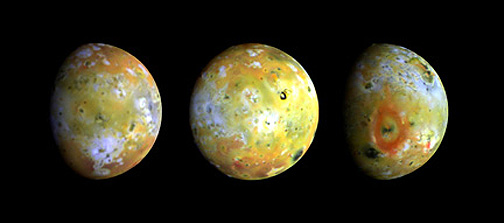
Io displays prominent orange colors, with blackish mottled areas (that has reminded some of a giant pizza with olives). This may well be rated as the most remarkable of all satellites in that the surface is undergoing constant dynamic change, largely through volcanic processes. One Voyager 1 image startled JPL scientists in having captured a major plume from the eruption of an ionian volcano that was then tossing material up to 300 km (186 miles) above its surface. Other eruptions were "caught in the act"
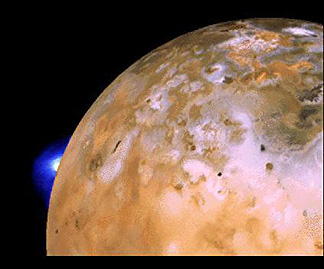
during the fly-bys, meaning that, along with signs of young surface deposits, for its size Io is more volcanically active than Earth. Another volcano, the caldera Pele, was imaged after it had discharged sulphurous lava, ash and gases out several hundred kilometers in all directions, forming a heart-shaped halo deposit (SO2 frost) named the Matuike Patera (volcanic field).

Scores of eruption sites have now been identified; many may be inactive but at least 30 appeared to undergo one or more events during the observation periods. The entire ionian surface is dominated by volcanic deposits, some being flows and others probably fragmental. Many of these can be traced to calderas. None of the volcanoes appear to be high stratocones such as are displayed as the majestic volcanic peaks observed in the Ring of Fire on Earth. Where some relief is evident, the Ionian volcanoes are more like terrestrial shield volcanoes, many with wide calderas.
The volcanic materials are likely silicates mixed with large amounts of (native?) sulphur and sulphur compounds (these can account for Io's orange, yellow, and black colors that are typical of this element). Sulphur dioxide makes up a tenuous atmosphere. Volcanic sites can undergo significant resurfacing changes in just a few years, as demonstrated by this series of images taken over the last 10 years from Voyager 1 through Galileo (upper left) around the volcanic complex known as Ra Patera:
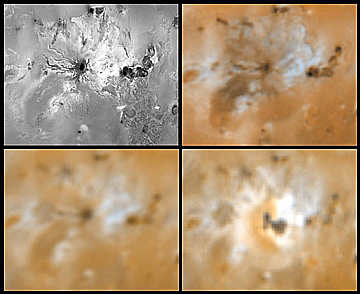
The cause of this (totally unexpected) activity on Io is a process termed "tidal pumping" in which the outer part of this satellite is flexed and stretched as much as 100 m (328 ft) as it is tugged from within by Jupiter and beyond by Europa and Ganymede. The tidal energies acting on Io induce heating even as it also is made to wobble from the interactions.
Europa (diameter = 3140 km (1950 miles), 671,000 km (416690 miles) out from Jupiter, as it appears from Galileo:
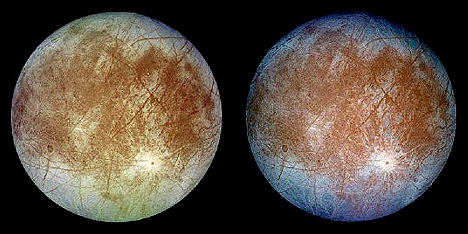
has reminded some of a giant "cue ball" that has cracked with age. The top view is a natural color image; that on the bottom is a false color image made by projecting the violet band through blue; the green band through green, and the IR through red. Seen by Voyager close up, the surface is extremely smooth, with few markings (minimal

craters) other than the pronounced sets of darker brown "fractures" that divide the crust into polygonal segments. These cracks are only slightly higher or lower (<300 m [984 ft]) than the main surface that appears to be H2O ice which may top an ice-water slush or a pure water "ocean" at some depth before grading again into ice and then rocky material. A view of this surface from Galileo shows:
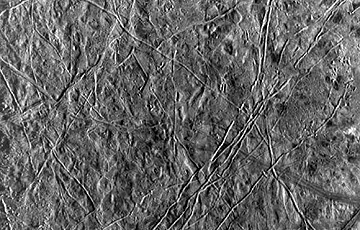
At this higher resolution, one can see several orders (size discontinuities) of fracturing. Some are distinctly curvilinear (a common pattern in rapidly cooled liquids, such as makes silicate glass). Slivers of dark material are scattered within. On Europa,
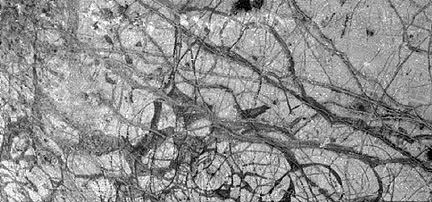
some interior rocky material may be intermixed with the ice. The origin of these linear breaks is uncertain. Comparisons have been made with polar sea ice on Earth which experience cracks or "leads" by tension as they are flexed by water currents; these cracks then reheal. Ridges formed by compression are an alternative.
More light was shed on this as Galileo made during a close approach to Europa on February 20, 1997, at a nearest distance of 586 km (364 miles). The picture on the top shows close-spaced parallel cracks in blocks with different orientations, separated by a high ridge furrowed in its center. On the bottom are "ice rafts" rising above surrounding ice.
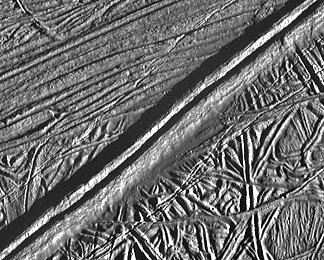
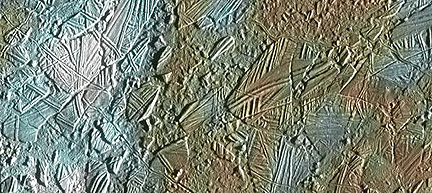
These appear to be break-ups of a thin ice cover (with its leads) in which the rafts are free to move about, additional evidence favoring a liquid water body below. The implication of an "ocean" with a frozen crust has led some scientists to speculate that conditions may be favorable for existence of primitive life in this liquid. This supposition has fueled intense interest in the possibility such that even closer approaches to Europa are now scheduled in the continuing Galileo observations and plans are under consideration for a new mission in the next century specifically to search for more signs of possible life.
More recent observations shed further light on the variety of terrains on Europa. The scene below, covering an area of 7 by 4 km, shows a chaos of small plates and wedges in an area known as Conamara Chaos. This December 16, 1997 image reveals chunks of ice, perhaps bound to each other by a matrix of ice mush, including several hillocks rising to 250 m (800 ft). Note the single flat lineated plate at the top. On the left is a straight chasm that is nearly 400 m across.
Code 935, Goddard Space Flight Center, NASA
Written by: Nicholas M. Short, Sr. email: nmshort@epix.net
and
Jon Robinson email: Jon.W.Robinson.1@gsfc.nasa.gov
Webmaster: Bill Dickinson Jr. email: rstwebmaster@gsti.com
Web Production: Christiane Robinson, Terri Ho and Nannette Fekete
Updated: 1999.03.15.